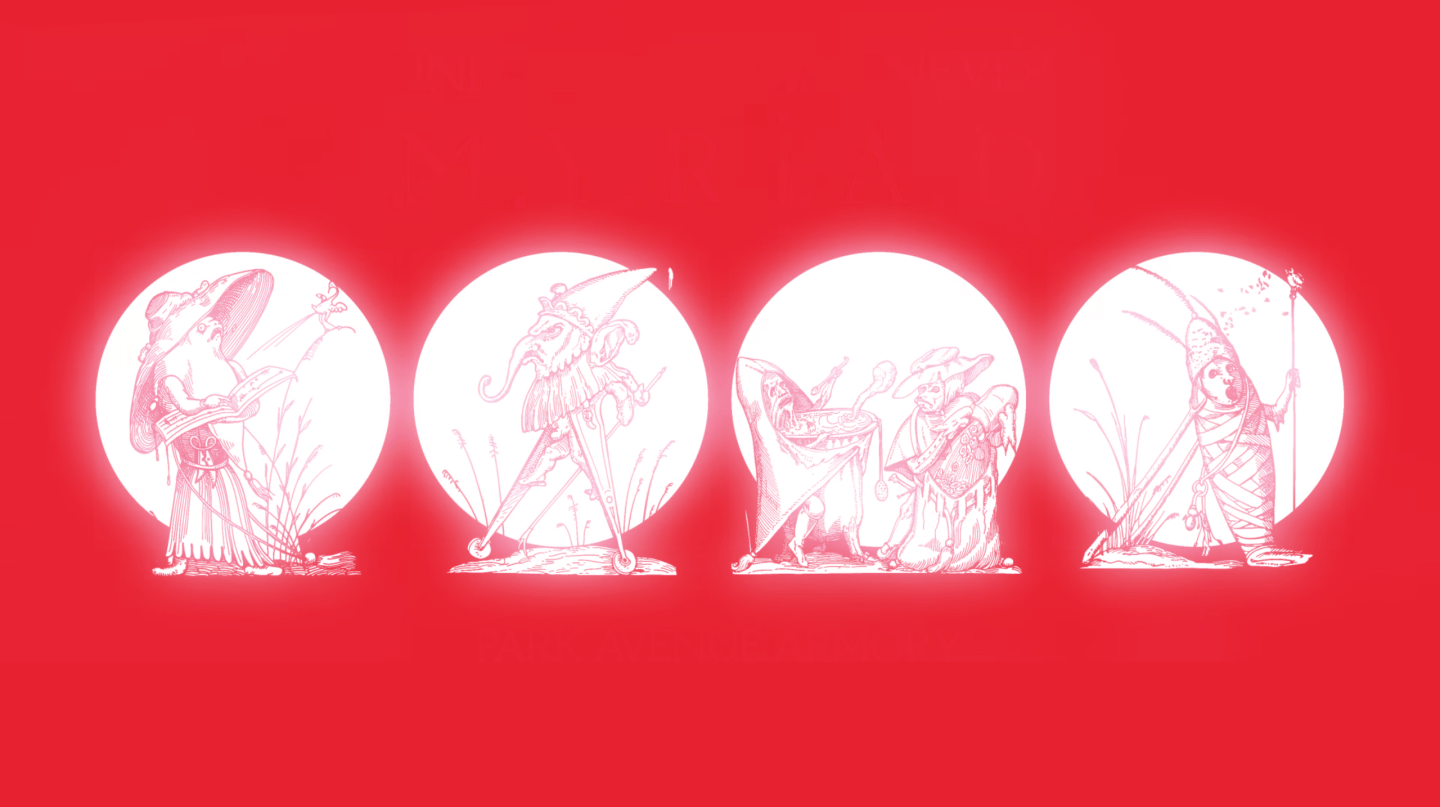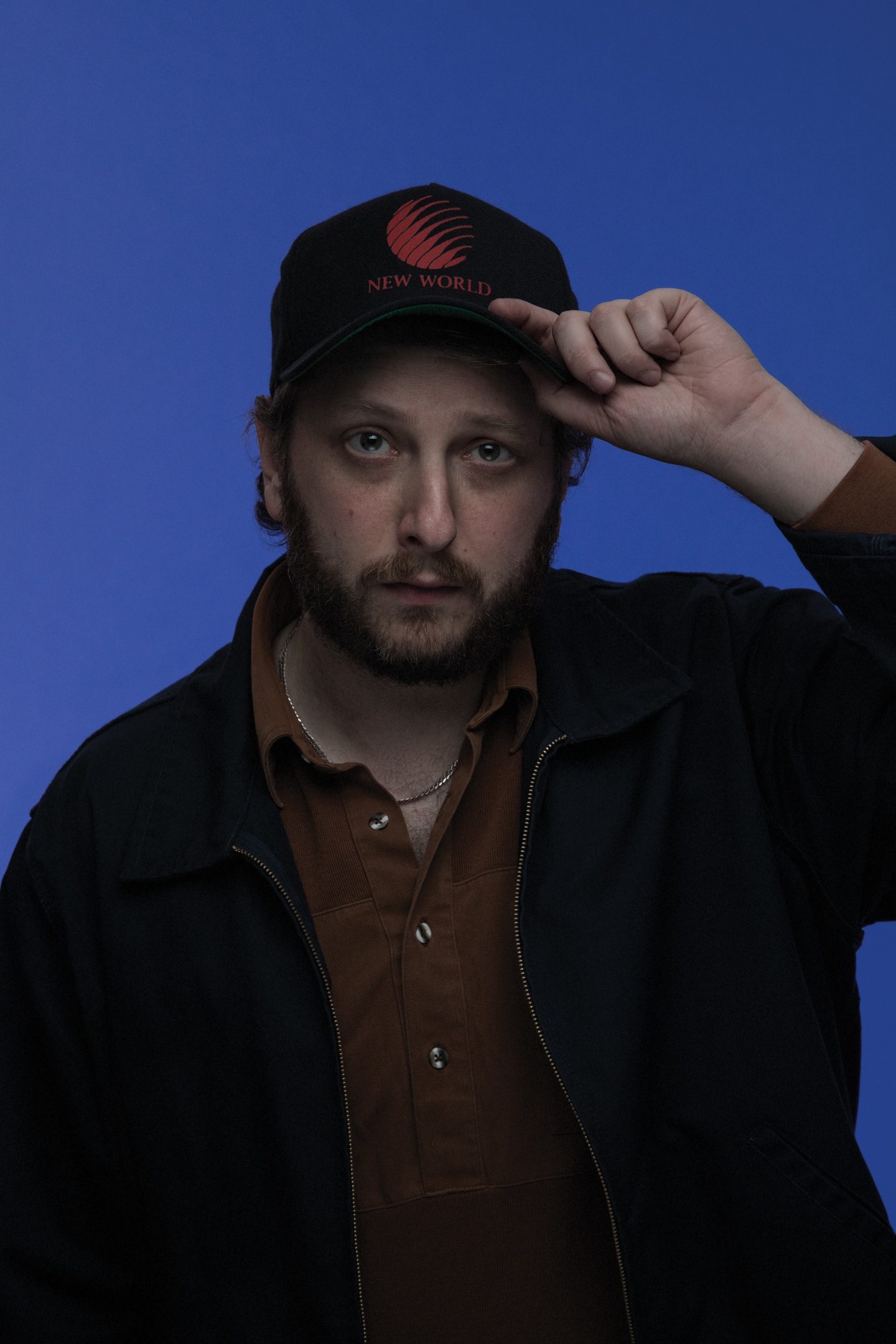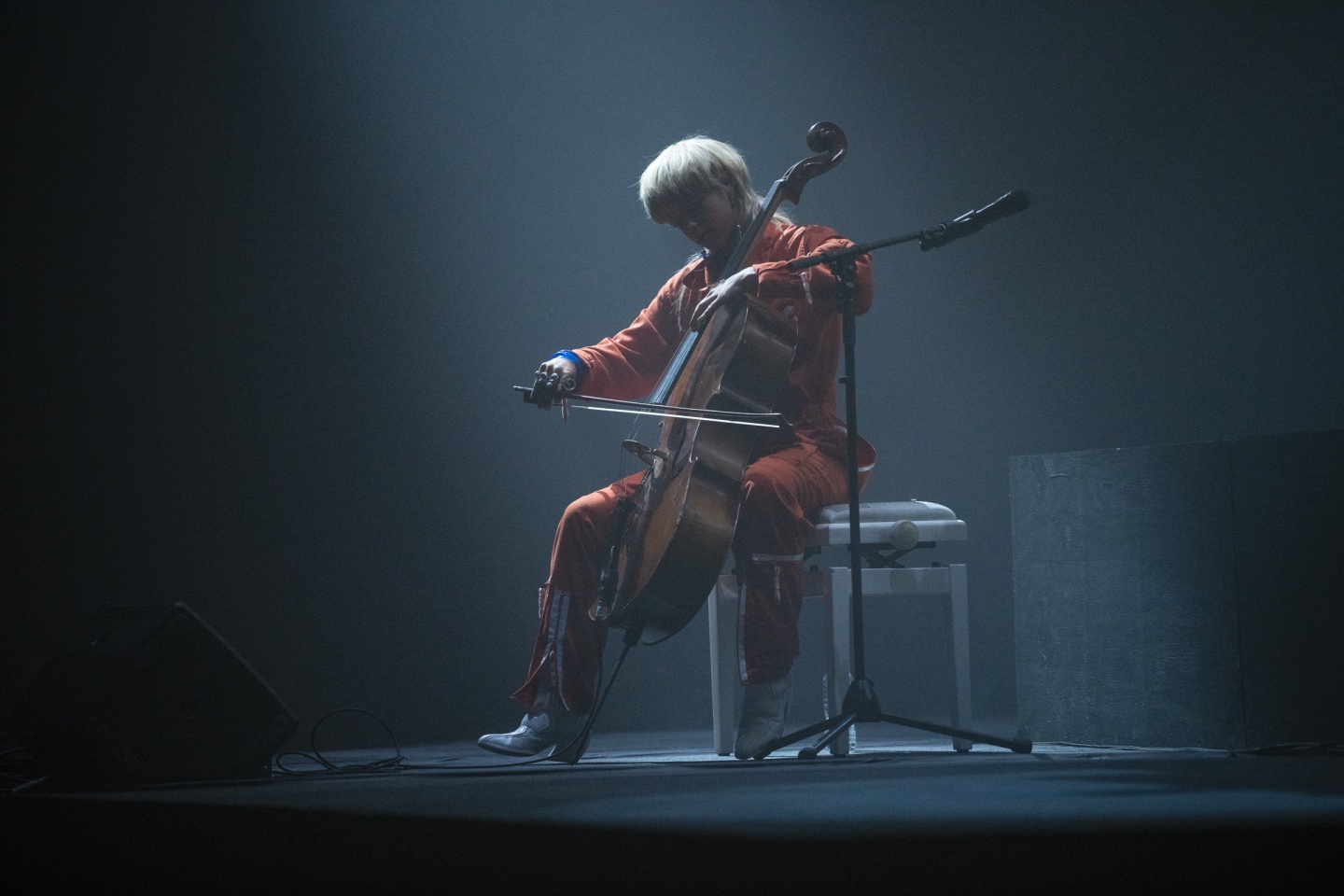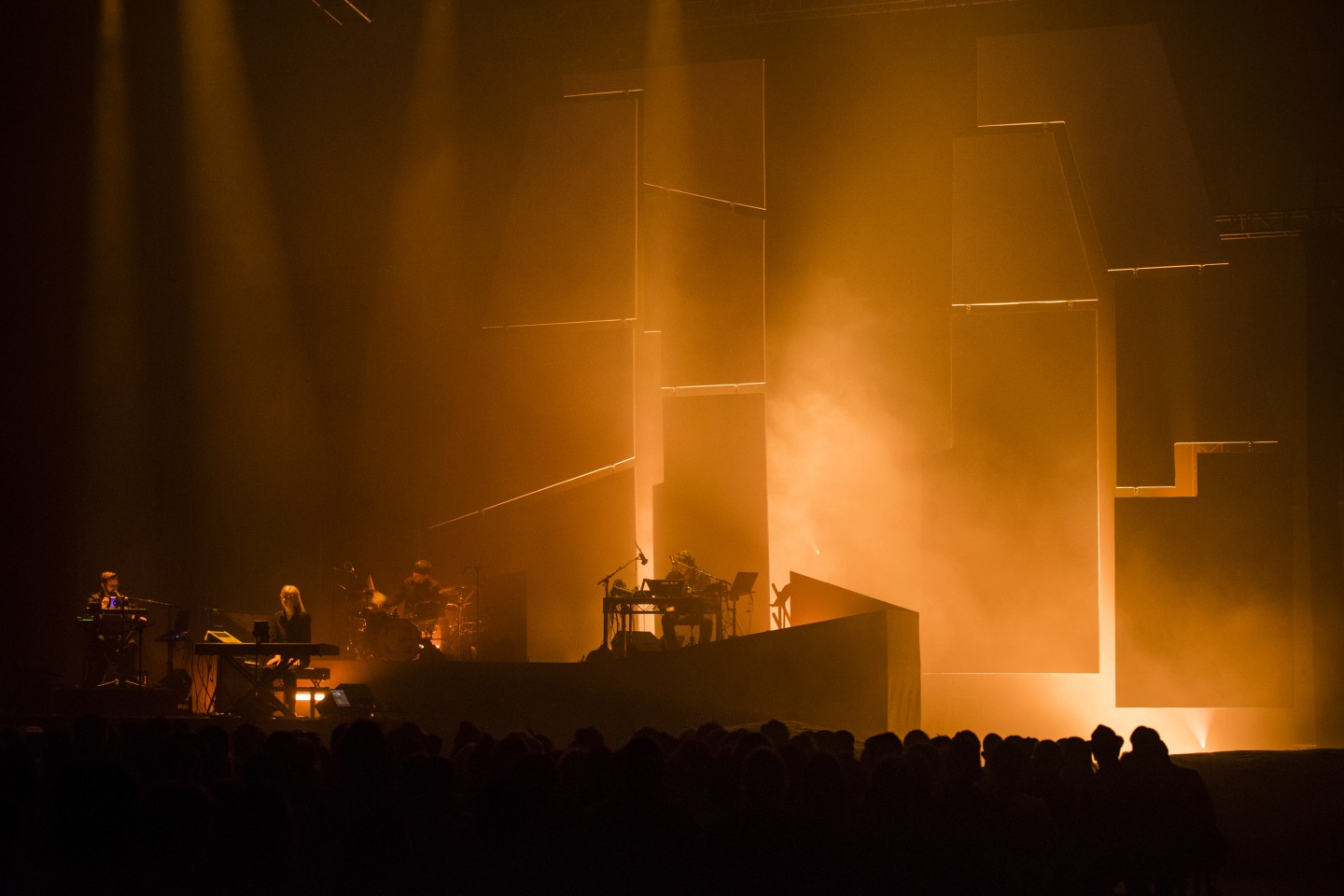
Over the last decade, Daniel Lopatin has established himself as one of the most forward-thinking and singular voices in electronic music. With his Oneohtrix Point Never project, the New England-born, Brooklyn-based experimental artist crafts reference-loaded and quixotic sound worlds that feel like a total convergence of the past, present, and future.
His latest full-length for Warp, Age Of, is no different — especially when it comes to his own history. Although the record's distinctly melodic and pop-structured flavor is the latest left turn in the ever-mutating development of the OPN sound, Age Of also plays out like a travelogue of Lopatin's oeuvre, from the spare, pointillist sounds of 2013's R Plus Seven to the skyward sampledelia of 2011's Replica and the synthetic swarm of 2009's Rifts.
Age Of also represents more of a collaborative effort than anything in the OPN catalog to date, with artists across multiple mediums contributing to a beguiling and cohesive whole. That said, it's no coincidence that while working on Age Of, Lopatin was also plotting "MYRIAD," his biggest concert experience to date.
Here, we talk to Lopatin and many of his co-conspirators for an exegesis-like exploration of both Age Of and "MYRIAD." It’s an in-depth look at what went into creating these fascinating works, full of testimonials to the creative spirit and new insight into Lopatin’s heady, conceptual approach.
The making of Age Of
Daniel Lopatin: I knew I was making a downtempo OPN record that hit a personal register — one that had songs where I was singing, and very little effects. I was entering a world where I was making very specific choices, but since I'd worked for a long time without anyone around, I had no idea if the choices were interesting. At some point, I was like, OK, I should try to finish this record, so I should start talking to mixing engineers. I started talking to very technically apt people, but they were all talking about what they were good at doing, and I was like, "I don't ever want to have these conversations — I want to talk to a musician."
There are a handful of people who I think as musical geniuses that I have access to, and James Blake is one of them. We've encountered each other a couple of times at concerts — ships passing in the night, and that was it. But thinking about mixing, I was like, Why don't you just play the record for James and see what he thinks? He had a really strong reaction to it, which was very surprising to me. He said, "When can we start working on this?" [There] was this intensity that emerged through a couple of emails. I just rolled with it, because I feed off of other people’s excitement.
[James Blake declined to be interviewed for this feature.]
 Daniel Lopatin
Atiba Jefferson
Daniel Lopatin
Atiba Jefferson
"My friends always tell me, 'You're the best at the internet of everyone I know.' If that's the general consensus, I guess it’s probably true.” — Daniel Lopatin
Lopatin: Anohni getting involved was some very serendipitous stuff. She spends a lot of time in Ireland and Germany, mostly focusing on her visual art. She hasn't been singing much. I had the record in a pretty good place, and I sent her the music. She said, "I'm gonna be in New York — I can't guarantee you'll like what I do because I haven't been singing, but let's do this."
Anohni (Vocals, "Black Snow"/"We'll Take It"/"Same"/"Still Stuff That Doesn't Happen"): Dan is a gentle fellow with a brain bigger than a cow's intestine. And he is kind. We are kindred spirits in our ways of seeing the world in some respects. He is a mad professor in the studio. He always treats me with a lot of respect and I have always tried to sing my guts out for him. He has inspired me in his approach to dismantling and reconstituting materials.
Lopatin: "Same" is amazing because we wrote the lyrics on the spot right there. Anohni got in the booth and was like, "I get it, but I need lyrics." I said, "I was hoping you had something in your books!" Because she always carries these amazing lyric books. She was like, "Write lyrics." So I had to do it on the spot. I ended up creating a very simple lyric that was this weird tesseract that keeps getting slightly augmented every time it goes through. I'd been reading Nicholas Bolstrum's A.I. Risk stuff on the internet and was like, "Wouldn't it be cool if we did this crazy dirge about the culmination where we can no longer tell A.I. from ourselves?" Same above as below, but with some Biblical color to it.
From the get-go, "Same" had this melody that I thought of as a military march — an "I don't know what I've been told" kind of thing. I wanted to do a military march with subject matter that was diametrically opposed to the military. From the outset, I wanted a choir to sing it, and I found some interesting transgender ex-military groups. It ended up becoming too complicated to coordinate, but it's kind of sweet the way it ended up how it did. It's much more close to home since Anohni and I are such good friends.
Kelsey Lu (Keyboards, "Manifold"/"Last Known Image of a Song"; guest artist, “MYRIAD”): Dan sent me the music while I was at this residency in Brazil — he got invited to it, too, but he didn't come. I listened to it, and it was unlike anything I’d been offered to play on, which was really exciting.
Lopatin: When I saw Lu play live, it'd been a while since I saw someone do music that was so open and heartfelt — with a looping pedal. Selfishly, it reminded me a little bit of me, because that's how I used to do things. I was in my own weird idiosyncratic lane, but she was doing it at a completely different level, which was so inspiring. The hairs on my arms were standing, and I was like, "I don't understand what I'm seeing — it's an Arthur Russell thing, but also Nina Simone, and really contemporary." I was moved, and I've had that feeling very few times in the last few years.
Lu: When I came to New York to work [with Dan], I didn't bring my cello because I was getting work done on it — but I still wanted to come. I didn't even tell him I didn't have it until I got there, because I wanted to branch outside of just being the cello gal. Listening to his music was inspiring to me, [thinking about all] the ways one could express themselves in that world.
Lopatin: We just have a lot in common that way — we both hear this circular music, but we have interest in the song form, too. She felt like a real cohort and companion.
Lu: There were a bunch of other guys in the room. White guys. Dan was like, "How do you usually like to work?" And I was like, "Not with this many guys in a room." [Laughs] He immediately was like, "Everybody get out," and it was a blank canvas from there. I felt really comfortable in a way that I don't normally. There's this level of vulnerability I always have, and he had a level of respect for that. It was really exciting for me — to be able to express myself in a new way with someone else.
Lopatin: I wasn't in a particularly sentimental mood when I was cutting this record, but I was interested in doing something that had a lot of historical and personal avenues. There was this need to reach for a more coarse brush, and I could've done it, but [Dominic Fernow, a.k.a. Prurient] is one of the best at doing it. His voice is an instrument.
 Kelsey Lu
Todd Owyoung / Red Bull Content Pool
Kelsey Lu
Todd Owyoung / Red Bull Content Pool
Dominic Fernow (Vocals, "Babylon"/"Warning"/"Same"; guest artist, “MYRIAD”): I was really interested in the project because Dan is one of the only people making content-driven work that crosses between actual subcultures and pop. Beyond creating cool rips and patterns, he's a real musician. I immediately said yes, and when I came into the studio, it became a spontaneous and unexpected process. I was like, "Can I jump in here and respond to this material?" And he was very supportive of it. I'm mercurial and work viscerally, and Dan is so layered, which was a good combination. You have to give him complete credit for being able to extract something from the chaos that I was generating.
Lopatin: My favorite musicians are always instrumentalizing their bodies. They become this thing that can emote; they're in touch with form. Because the record has this epochal cycle thing happening, and this dark alleyway that deals with agony and anxiety, it was much more interesting to have a professional handle that.
Fernow: Once a lot of musicians pass a certain point, they want to run away from their mistakes — I look back at my discography, and there's a lot of mistakes. I give Dan a lot of credit for being able to harness, with authenticity, his own history, while also creating a future for himself at the same time. He did that with "MYRIAD," too, with guest musicians that are ferociously talented but you wouldn't be able to close your eyes and imagine them all working together. A good curator bridges gaps, and I think he does that in a really radical way.
“Dan is a gentle fellow with a brain bigger than a cow’s intestine.” — Anohni
Lopatin: Working with Rudnick was a fun, poppy thing to do. Everyone expects on some level that my records aren't ensconced in someone like David's specificity, but that's exactly what I wanted.
David Rudnick (Cover art for Age Of's physical release): I was in New York last autumn and I ended up going to Dan's little studio in Brooklyn. He had reached out to me and said "There's something I'm working on — would you be interested in checking out what's going on?" Listening to what he was working on musically and hearing his visions for "MYRIAD," ideas began to flow. Working with him was a remarkable process. I was emotionally moved by the work in a way that was really rare.
Lopatin: David made a weird latticework to put that Jim Shaw image on, which is the most OPN thing possible. I've never made a record before where, art-wise I was like, "I"ll never be able to top this."
Rudnick: I was a little wary of working directly with him, because I didn't want to try to mimic the voice of a scene that I'd never been a huge part of myself. There was something about Dan's idiomatic vernacular that felt virtuosic and American; he's able to go into the trash heap of culture and find gems. My instinct working graphically is that I try to avoid nostalgia and overt references to familiarity, but I was really surprised by the realization that Dan's practice is equally and richly fascinated with the idea of history — he just disassociates with the present.
Ezra Miller (Website designer): I was familiar with Dan’s work after discovering his music when I was in high school, and seeing him perform Garden of Delete in Boston in 2016, which really blew me away. I always loved the visuals he would create. I got involved through my work with Warp and David Rudnick, who asked me if I wanted to help be involved on the project's website. We designed something that would highlight the scope of [Dan’s] career, almost separate from the entire Age Of universe — a place where Dan’s other work could live and expand throughout the years, an archive and platform.
Lopatin: I've had a shit website for years — I used to have a cool website during web 1.0, but then web 2.0 happened and I got signed to Warp, and all the specificity and trashiness of my website went out the window. Then I decided to abscond completely from having a website, and I'd just have it there as a brochure — like when they hand out religious pamphlets on the street. David brought in Ezra as a suggestion for revamping it, and I just let him run with it to make this insane thing.
Miller: Working on Age Of made me understand what being an artist means, because Dan embodies it out of any musician I’ve ever met. He has a way of making music that evokes every emotion possible, and I think he’s inspired so many musicians through his commitment to reaching this level of artistry. As someone who went from being a fan to a collaborator and peer, it’s been an amazing experience to work with Dan, because he’s so down to earth and genuine.

Eli Keszler (Percussionist, Age Of; MYRIAD Ensemble): I've known Dan going back to the New England music scene, which we were both a part of years ago. We have talked about working together for almost as long and the music and timing finally was right to make it happen.
Lopatin: I'm so terrified of drums in my music, so the drummer needed to be more of a percussionist, [someone capable of] really extended, strange playing that brought something beyond an anchoring role.
Keszler: When we went into the studio to track drums for Age Of, Dan gave me many pieces and works-in-process. He gives a lot of room to the individual to bring their own minds to the project, to really invent and become a part of the music. He has an incredible instinct for putting music together. He also is able to translate his ideas into space, which is an extremely rare gift.
Behind the scenes of "MYRIAD"
Part of the Red Bull Music Festival, "MYRIAD" debuted in late May at New York City's cavernous Park Avenue Armory art space. The unforgettable “concertscape” — which unfurled something like a large-scale prog show festooned with bright lights, strange sculptures, and zonked-out visuals — was the result of Lopatin joining together Age Of collaborators, previous cohorts, and new additions to his artistic universe.
Daniel Lopatin: Everyone in the group is a really strong individual artist, so it was interesting to coax them to converge for "MYRIAD." It was an Avengers situation, where we could all still do our superpower moves. It felt less like a band and more like a band of musical adventurers, with lots of potential for everyone to flex in their own ways.
 "MYRIAD" live at the Park Avenue Armory
Drew Gurian / Red Bull Content Pool
"MYRIAD" live at the Park Avenue Armory
Drew Gurian / Red Bull Content Pool
“A good curator bridges gaps, and I think he does that in a really radical way.” — Dominic Fernow (Prurient)
Griffin Frazen (Stage design/Set/Overall creative): I’m trained as an architect, but I had done a few live shows with musicians and was gravitating toward immersive, physical space. This was the first time Dan had the need for an architect and set designer — someone to help execute a live show on significantly larger scale.
Lopatin: I knew Griffin peripherally, and then I saw his work with Solange and thought it was really next-level. We threw some initial ideas back and forth to see if there could be grease on the wheels aesthetically. We get along so well.
Frazen: Dan and I started talking about the show last summer, before the album had been recorded. He had a basic premise and a lot of reference imagery from disparate corners of culture — most of it was stuff I knew or really identified with. The challenge was turning it into a coherent show. He likes to use this term “compressionism” to describe his work — the act of pulling bits and pieces from the massive amount of historical and cultural inputs we are exposed to and converting it into something digestible, but not necessarily fully comprehensible. Architects and designers are compressionists by definition; they take concepts and convert them into objects and ideas for real life. It was really ambitious, but we managed to pack almost everything into the show with remarkably few compromises.

Lopatin: We went up to The EMPAC to workshop concert stuff, which is an OPN tradition. It got really interesting when [inflatable designer Jesse Seegers] and Griffin got up there, because there were people working in these rooms in concentric circles. We'd go in and see what they were working on, we'd trip out on that, and it'd give us energy. It was a family affair, but with new people.
Frazen: In the middle of developing the live show, the music video for "Black Snow" came up. Dan had a pretty specific idea for the video, and sent me a rough outline with references including news media images of the Fukushima disaster, Dolly Parton album covers, and other illustrations. It was a great exercise for us to do the video together in advance of the "MYRIAD" shows, as it shares the same thematic ideas as the live show and the album. Some of the props and characters from the video even make an appearance in the show.
Lopatin: Griffin did so much work on the "Black Snow" video as a set designer and de facto assistant director, in a way. He's really hard-working and principled, and his architectural background is really inspiring to me.
Nate Boyce (Sculpture/Video): I've been involved with OPN since around 2009 when I first made the video for “Russian Mind.” Ever since, I've performed live visuals alongside Dan at almost every OPN show except for a few special projects.
Lopatin: I can send him an email with a song title and images that are totally illogical — like a still from Teenage Mutant Turtles 2: Secret of the Ooze — but he'll know what I mean.
Boyce: We've been talking about this idea of the “concertscape” for years now. With "MYRIAD," we were finally able to bring the ideas to real fruition. It continued a long-term investigation into the relationship between sculptural form and musical affect.
Lopatin: It was a challenge posed to Nate to do more figurative, narrative stuff — which typically he's not that interested in as an artist. Our curiosity was piqued: how could we augment those types of things to feel like they're still in the lexicon of feeling that we like to inspire in people? I had this quasi-libretto — there's no way it's an actual libretto, because it's not an actual opera. But there is a story to "MYRIAD," and it was very easy to fashion CG scenes around these themes. In that way, it didn't feel different from how we usually work.
From there, it was about reaching a consensus level of what is possible. I was asking for these Pixar mini-vignettes, and he'd be like, "Right—we have 17 hours." But we also had some amazing help from this crew of CG animators called Last Renaissance. We decided early on we were going to mess around with this idea of archetypes — these broad, sweeping ideas of character. We had these vaguely formal and surrealistic exercises that we'd get into just by shooting the shit.
We had this one called the Triumphant Proletariat, who only exists in the Age of Harvest. He looks like a cross between an early Renaissance sculpture and a propagandistic poster from the Soviet Union about farming — this bronze-emblazoned thing that is both an agrarian instrument and a human form. He's stuck on this floating island, harvesting and digging, and extracting crop. He's in this feedback-loop timeline of success, to no end and for no one to benefit from — including himself.
 "MYRIAD" live at the Park Avenue Armory
Todd Owyoung / Red Bull Content Pool
"MYRIAD" live at the Park Avenue Armory
Todd Owyoung / Red Bull Content Pool
“Dan is the most driven person I know. He basically never stops grinding, voraciously ingesting and indexing all facets of culture.” — Nate Boyce
Boyce: Dan is the most driven person I know. He basically never stops grinding and always wants to take things to the next level, voraciously ingesting and indexing all facets of culture. Sometimes I forget he has a Library Sciences degree. His humor permeates all of his exploits, no matter how rigorous. He's such an anomaly in that he has such a mind for logistics while being such an expressive and intuitive artist.
Lopatin: I discovered Kelly Moran through this group Voice Coils, which Mitski [has also sung with]. They're one of my favorite Brooklyn bands in recent years — dark, proggy, very medieval. I was so obsessed with her playing, and discovered her prepared piano work as a solo artist. We started talking on Twitter, and I reached out and was like, "Hey, I'm a big fan of what you do."
Kelly Moran (Keys, MYRIAD Ensemble): The first time I ever talked to Dan was through a random Twitter interaction in early 2015, when he was angrily subtweeting about someone’s record that had been leaked. I assumed he was talking about Rihanna, but then he replied and clarified that he was talking about Tim Hecker’s Love Streams. I felt so stupid and instantly apologized, and I think he felt bad that he sounded grumpy in his replies, so he went to my Twitter page, clicked on the link for my bandcamp and told me my music sounded amazing. I said, "Thank you, I’m a huge fan of your work!" Then, in October of 2017, he messaged me out of the blue to let me know he was a huge fan of my old band and thought that I would be perfect for a project of his in the works.
Lopatin: My friends always tell me, "You're the best at the internet of everyone I know." If that's the general consensus, I guess it's probably true. It doesn't take an enormous amount of courage for me to reach out to someone. Pre-Snapchat, I liked writing on social media more. I was great at the MySpace "About You" section. After "MYRIAD," I had 52 messages on Instagram — I'd never had so many in my life. It is a little irritating to be so available; how much access do you want? As a human being, if you're a nice person, you're not going to change. I might have to start firewalling though.
Moran: When we first got together in October, I was a little bit starstruck and nervous. I immediately felt at ease with him because he was so sweet and down to earth. He never makes anyone feel like they’re less than him. After being in the music industry for my whole life, it was really refreshing to be on a project with him, because the people he chooses to work with treat each other very well and uplift one another. It’s been very life-affirming to me that one of my personal heroes also turned out to be a kind human being with a wonderful heart.